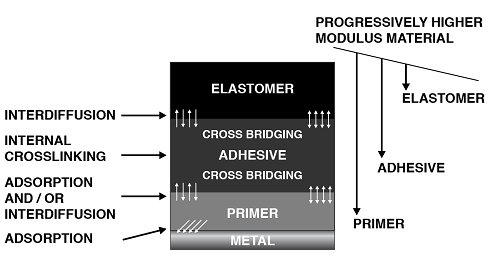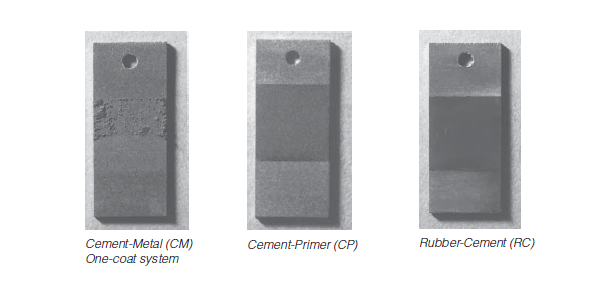LORD Corporation
With more than 3,100 employees in 26 countries, 19 manufacturing facilities and 10 R&D centers worldwide, we're there for our customers.
Our Company
-
Products and Solutions
To speak to someone directly, call
Customer Support:
8AM–5PM EST
Technical Support:
8AM–5PM EST
-
Industries
To speak to someone directly, call
Customer Support:
8AM–5PM EST
Technical Support:
8AM–5PM EST
-
Our Company
To speak to someone directly, call
Customer Support:
8AM–5PM EST
Technical Support:
8AM–5PM EST
-
Feedback Button
Feedback Button
Background - Rubber-to-Metal Bonding
Engineered rubber-to-metal devices enable key performance attributes for automotive, industrial and aerospace applications. These critical parts rely on a dependable bond being formed between the rubber and the substrate (typically metal) in order to be successfully used in service. Historically, several methods have been employed in an effort to achieve a dependable rubber-to-metal bond. Initial efforts utilized ebonite, brass plating, multiple tie coats, and polyisocyanates as a means for bonding; however, these methods each had their own shortcomings.
In 1956, a substantial advancement in rubber-to-metal bonding was made when LORD Corporation commercialized its Chemlok® 205/220 system. This primer/adhesive system allowed for bonding to a wide variety of available elastomers, while enabling substantial improvements in service performance. Since this time, numerous advancements have been made with rubber-to-metal adhesive systems to meet the changing requirements of the markets they serve.
Today, rubber-to-metal adhesives are commercially available in a wide variety of forms to meet the needs of the end user. Both one- and two-component systems can be used, and they are available under the following categories: solventbased, low-HAPs (Hazardous Air Pollutant), environmentally preferred, and aqueous (water-based). Materials Engineers must carefully consider the importance of selecting a proper adhesive system for their application as these bonds must be capable of withstanding potentially harsh exposure environments. This page will discuss the adhesion science involved in rubber-to-metal bonding as well as provide some general considerations for achieving a robust rubber-to-metal bond.
Rubber-to-Metal Adhesion
Historically, several bonding methods have been employed within the rubber industry in an effort to achieve a dependable and durable rubber-to-metal bond. Modern adhesive technologies utilize both singleand two-coat adhesive formulations, with the preference depending upon the service needs of the bonded assembly. For example, a two-coat system would be preferred for applications involving exposure to harsh environmental conditions, such as automotive applications. For the purposes of this paper, two-coat systems will be the focus.
Two-coat adhesive systems are comprised of a primer layer and an adhesive topcoat. The primer provides a means of obtaining robust adhesion to the metal substrate while providing the necessary reactivity with the adhesive topcoat. A primer also provides heat- and corrosion-resistant properties that are desirable for applications involving harsh environmental service conditions. A typical primer is comprised of film-forming polymers, crosslinkable resins, fillers, and a solvent or water-based carrier system.
Figure 1 - Rubber-to-Metal Bonded Assembly
 An adhesive topcoat is applied to the dried primer. The topcoat provides a means of reacting with unsaturation in the elastomer backbone, typically during the molding process. The topcoat also must react with the primer layer such that adhesive and primer intercoat adhesion is achieved. A typical adhesive topcoat would be comprised of curatives, film-forming polymers, fillers, and a carrier system.
An adhesive topcoat is applied to the dried primer. The topcoat provides a means of reacting with unsaturation in the elastomer backbone, typically during the molding process. The topcoat also must react with the primer layer such that adhesive and primer intercoat adhesion is achieved. A typical adhesive topcoat would be comprised of curatives, film-forming polymers, fillers, and a carrier system.
Within the bonded assembly, there are various interactions occurring at each of the interfaces such that overall adhesion is achieved. The primer-to-metal interface involves adsorption and/or chelation of the primer components at the surface of the metal. The primer-to adhesive interface obtains intercoat adhesion through the adsorption and/or diffusion of respective components within the layers. Crossbridging of reactive topcoat chemistries into the primer and the elastomer also occurs at each of these respective layers’ interfaces. Within the adhesive and primer layers, internal crosslinking of the polymeric systems also occur.
The layers of components within the bonded assembly are arranged in such a way that they are progressively decreasing in modulus from the primer to the elastomer. This can be seen in the bonded assembly illustrated in Figure 1. The reason for this arrangement is to provide a gradient in the stiffness change between the substrate and the elastomer, eliminating a sharp interface.
Rubber-to-Metal Bonding Process
The consistent production of robust rubber-to-metal bonded assemblies involves consideration of five fundamental concepts: elastomer type, surface preparation, primer/adhesive preparation, and molding. Each step is equivalent in terms of importance, and they each require a high level of attention during the design and process development phase. A sound process control plan will also lead to the production of robust bonded assemblies. The following sections discuss each of the fundamentals in further detail.
For more information on elastomer bonding principles and choosing the right elastomer / adhesive combination click here.
Elastomer TypeThe first item that needs to be considered when deciding on a proper adhesive system is the type of elastomer that will be utilized. Some elastomers are considered easier to bond than others due to higher degrees of polarity and higher levels of unsaturation. This can be viewed as a bondability index which is shown in Figure 2. There are various adhesive formulations tailored to bond different types of general purpose and specialty elastomers.
It should also be considered that compounding plays an important role in the bondability of elastomers. With regards to filler levels, the type and amount of filler plays a role in bondability. For example, compounds with less than 40 p.h.r. (part per hundred rubber) carbon black are typically found to be more difficult to bond than those with higher levels. Also, the inclusion of clays and silicas in the compound tend to help with bonding. The sulfur level in a compound also plays a significant role in bondability as compounds with little or no sulfur can be difficult to bond. At least 1 p.h.r. sulfur in the compound has been found to promote bonding. Attention also needs to be given to the bonding impact of various accelerators, oils, extenders, and antidegradants that are being utilized in the compound.
The next fundamental in the bonding process is the surface preparation of the metal substrate. A properly prepared metal surface is an essential step for obtaining optimum bond performance. The first action in preparing the metal surface is to remove all of the processing oils and lubricants from the surface. This can be accomplished through the use of solvent degreasing methods or an alkaline cleaning process. Insoluble materials, such as rust, also need to be removed from the metal surface. This can be accomplished through the use of mechanical treatment methods such as blasting with steel or aluminum oxide grit, abrading, or machining.
Often, part applications require exposure to harsh environments. In such instances, a chemical treatment of the metal may be required to prevent oxidation. Chemical treatment of the metal is typically in the form of zinc or iron phosphate for steel, acid etching for stainless steel, and chromate alodizing or anodizing processes for aluminum. This chemical metal treatment also serves to protect bond integrity. Once the metal parts have been prepared, it is recommended that primer be applied as soon as possible. If a layover between preparing and priming parts must take place, it is important to prevent contamination of the metal surface.
Primer/Adhesive PreparationThe next step in the bonding process is to ensure that the primer and adhesive are ready for use. In preparing an adhesive system for use, it is first necessary to bring the materials to the expected operating temperature. This is important as the temperature will have an impact on the product’s viscosity. It is also extremely important to properly agitate the primer and adhesive to, and during, use. This allows for settled ingredients to become uniformly dispersed throughout the product during application. Agitation of solvent-based materials can take place through mixing or shaking; water-based systems should only be mixed at low rates (20-30 rpm) to prevent foaming. Water-based systems should never be shaken for the same reason. Solvent-based systems should be mixed using explosion-proof equipment at a rate of 40-60 rpm. Table 1 gives typical guidelines for mixing solvent-based adhesive systems.
Finally, depending on the application method chosen, it may be necessary to dilute the adhesive system with the recommended diluent. Dilution to the appropriate product viscosity is critical for establishing a controlled process in which the appropriate film thicknesses are achieved. When diluting the primer or adhesive, it is important to add the diluents slowly so as to prevent material. This could lead to an irreversible gelling or phase separation of the material.
Primer/Adhesive ApplicationThe next aspect of the bonding process to be discussed is the application of the primer and adhesive system. Several methods of applying the primer and topcoat can be utilized; these include spraying, dipping, brushing, and rolling. Regardless of the method chosen, it is important to utilize a method in which the optimum recommended dry film thickness of the system can be achieved. In general, the recommended dry film thickness for optimum bonding performance is 0.005-0.010 mm for primers and 0.015-0.020 mm for the adhesive. Increased topcoat dry film thicknesses (0.02-0.038 mm) are recommended for post-vulcanization bonding applications.
The standard operation for applying a solvent-based adhesive system is to apply the primer to the prepared metal, dry the primer, apply the adhesive topcoat, and dry the topcoat. Water-based systems require a pre-heat of the metal prior to application; a target metal surface temperature of 322.15-333.15K is recommended. Drying of these materials can be done at room temperature, or it can be accelerated through the use of a circulating air oven at temperatures of 338.15-366.15K. It is important not to allow the surface temperature of the part to exceed 393.15K as this can prematurely adhesive. A schematic of a typical solvent-based adhesive spray application is shown in Figure 3.
Following application of the adhesive system, it is important that care be taken when handling the coated parts such that the adhesive surface does not get contaminated. For this reason, cotton gloves should be used when handling parts. It is also important to mold parts as soon as possible following coating. If layover is necessary, however, parts should be stored in sealed containers such that they cannot be exposed to contaminants and UV light. Adhesive manufacturers should be contacted for guidance on maximum layover times of coated parts.
MoldingRubber-to-metal parts are typically manufactured through the use of injection molding, transfer molding, or compression molding processes. Autoclaving and pressure-less steam molding are also used in some specialized applications. During the molding process, parameters must be carefully defined such that elastomer vulcanization and adhesive cure occur simultaneously. In addition, it is mandatory that intimate contact of the elastomer and adhesive be achieved during the molding cycle. This is accomplished through optimization of molding pressure and elastomer viscosity; this allows for proper wetting of the elastomer on the adhesive surface. It is also necessary to ensure that uniform temperature is maintained in each of the mold cavities throughout the molding cycle. Variations in temperature could lead to potential bond failures.
Another important aspect of the molding process involves heating of the coated parts when they are loaded into the mold cavities; this is known as prebake. It is important to optimize prebake conditions of the coated parts for the molding process. In some cases, too much heat can lead to premature curing of the adhesive system. In other cases, a lack of prebake may prevent the adhesive from activating during the mold cycle. The use of loading boards can help to ensure that all parts, in multiple cavity molds, are prebaked for the same amount of time.
The molding step is critical in obtaining a quality bond as both the elastomer and the adhesive system are dependent upon this step to cure/vulcanize in concert with one another. Lack of variable control during this step could lead to sporadic bond failures in the field.
For more information on elastomer bonding principles and choosing the right elastomer / adhesive combination click here.
Testing / Troubleshooting
Testing of rubber-to-metal bond performance is commonly performed to the guidelines of ASTM D 429-14. This test method describes eight types of test specimens and methods (Methods A through H) that can be utilized for bonding evaluations. Also identified within the test method are a means of identifying the type of adhesion failures. “R” is designated as rubber failure; this is the desirable failure mode for bonded assemblies as this indicates that the failure occurred within the rubber layer. “RC” indicates that the failure occurred at the Rubber-to-Cement (adhesive) interface. “CP” is failure at the Cement (adhesive) and Primer interface, and “CM” is failure at the Cement (adhesive) and Metal interface or the Metal to primer interface. Examples of these types of failures are shown in Figure 4.
Figure 4
Utilizing this nomenclature for failure mode allows for technical personnel to perform a more focused troubleshooting evaluation and identify the likely root cause. It has been found that greater than 50% of bond failures are RC failure, approximately 30% are CM failure, and the remainder is a combination of CP and cohesive failure (cohesive failure is a break within the primer or adhesive layer). It should be mentioned that the overwhelming majority of failures in the field are due to insufficient dry film thickness of the primer and/or topcoat. This serves to point up the importance of controlling adhesive film thickness on a given part.
For more information on elastomer bonding principles and testing rubber-to-metal bonds click here.
Summary
Rubber-to-metal adhesive systems are traditionally two-coat systems involving a primer and a topcoat/adhesive that can be utilized to bond a wide variety of elastomers to substrates (typically metal). The mechanism for adhesion relies upon a variety of interactions that occur between the interfaces of the metal, primer, adhesive, and elastomer. In order for an adhesive system to perform its function, it must be utilized properly. This involves consideration of five fundamental aspects of rubber-to-metal adhesion: elastomer type, metal preparation method, primer/adhesive preparation, primer/ adhesive application, and molding operation. Attention to detail regarding each of these aspects of the rubber-to-metal bonding process will allow for a robust bonding operation and a reliable finished part.
For more information on elastomer bonding principles and choosing the right elastomer / adhesive combination click here.